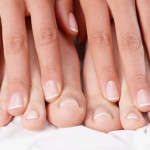What to Do for Psoriasis on Hands and Feet?
Psoriasis can affect any areas of the skin. However, there are some common areas where it occurs. Some of these areas are hands and feet. The disease is not contagious, but the symptoms on the affected skin can be very bothersome, even in severe case it may become life-threatening condition if left untreated.
Your feet and hands take about 4 percent of your total skin area. However, they are visible spots. Therefore, when psoriasis affects them, the problem can still significantly affect the quality of your life.
It can cause many uncomfortable symptoms from pain, itching, problem in using hands and feet – to the pickle about unsightly lesions. Eventually, it may also affect your productivity which then may cause a financial burden.
 The symptoms may vary, but typically it causes the following problems:
The symptoms may vary, but typically it causes the following problems:
- Cracking on the affected skin.
- Blisters may also occur.
- Thickening or/and swelling.
- Redness.
- Scaling.
Sometimes, the problem may resistant to a specific treatment. However, there is always a way to help ease and improve the symptom. Work with your dermatologist to keep finding a treatment that work more effectively.
Soles and palms are common areas of feet and hands where psoriasis occurs. However, the problem also can affect nails, knuckles, back of hands, or top of feet.
Several treatment options are available to help get rid of psoriasis in these areas. The following are pieces of helpful information about these treatments.
These can include the use of creams, ointments, or lotions – containing some active ingredients such as salicylic acid, tar, or corticosteroids. Doctor may recommend the combination of these ingredients for more effectively result. Sometime the use of calcipotriene may also be prescribed to help improve the problem.
Along with the topical treatment, the use of harsh soap is not recommended because this can make skin dry even more. Mild soaps are more recommended to wash your body safely.
To help the medicine work better and more effectively, there are some issues you need to concern. For instance, you should keep your weight under control! The medicine tends to be less effective if you are continuously gaining more pounds of excessive weight.
Furthermore, use cotton gloves in order to avoid the medicine accidentally touch non-targeted sties, particularly sensitive sites such as face.
Follow the treatment plan prescribed by your doctor as well. Work with him to find a treatment that works most effectively!
In some cases, the symptoms can be very bothersome. For instance – swelling and blistering may occur, and this can significantly affect the way of how you use your hands and feet. For this case, you may need to use super glue. You can use it to help seal deep fissures, but make sure you don’t have a super glue allergy!
Not all cases can be treated with topical treatments. Sometime, the topical medicine is not able to penetrate the affected areas.
When the topical treatments fail to work, doctors may choose alternative treatments such as:
- Methotrexate! It often effectively works for sole & palm psoriasis. The result of improvement usually can appear about 4-6 weeks after the treatment. Theoretically, it can help reduce the role of enzymes involved in the abnormally ‘too fast’ growth of skin cells.
- Other choices may include low doses of Soriatane or other retinoids. Ask a doctor for more advice!
The use of cyclosporine may also be helpful. It can help improve the function of immune system to keep running well. In other words, it help suppress the immune system (psoriasis is thought as a health condition that is related to the over-reactive immune system).



